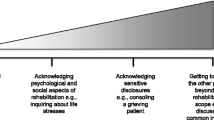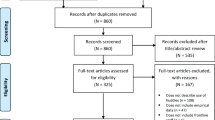Abstract
Background Studies from different fields documenting the differences between clinicians’ and workers’ representations have not elucidated where the differences exist or how they can be resolved. Purpose To define and describe scenarios depicting the differences between clinical judgment, workers’ representations about their disability and clinicians’ interpretations of these representations. Methods A multiple case-study design was used. Semi-structured prospective interviews were conducted at four points in time, with five clinicians managing 12 cases of workers having persistent pain and participating in an evidence-based work rehabilitation program. Results Four scenarios depicting differences in representations were found, but not all the differences necessarily had a negative impact on the program outcomes. For the clinicians, clear identification of the problem was important to allow for the use of concrete, pragmatic strategies. For the workers, congruence between the proposed strategy and their representations was crucial. Conclusion During rehabilitation, the objectives must be acceptable to both parties or the proposed strategy must, at least, make sense to the patient.
Similar content being viewed by others
References
Watson Wyatt Wordwide. Staying at work: making the connection to a healthy organization. Toronto: Canada; 2005.
Krause N, Dasinger LK, Deegan LJ, Rudolph L, Brand RJ. Psychosocial job factors and return-to-work after compensated low back injury: a disability phase-specific analysis. Am J Ind Med. 2001;40(4):374–92.
Foster NE, Thomas E, Bishop A, Dunn KM, Main C. Distinctiveness of psychological obstacles to recovery in low back pain patients in primary care. Pain. 2010;148:398–406.
Toombs SK. The meaning of illness: a phenomenological approach to the patient–physician relationship. J Med Philos. 1987;12(3):219–40.
Leventhal H, Brissette I, Leventhal EA. The common sense model of self-regulation of health and illness. In: Cameron L, Leventhal H, editors. The self-regulation of health and illness behaviour. London: Routledge; 2003. p. 42–65.
Leventhal H, Meyer D, Gutmann M, Haynes RB, Mattson ME, Engebretson O. The role of theory in the study of compliance to high blood pressure regimens. In: Anonymous, editor. Patient compliance to prescribed antihypertensive medication regimens: a report to the National Heart Lung and Blood Institute (NIH Publication No. 81–2102). Washington: U.S. Department of Health and Human Services; 1980.
Leventhal H, Zimmerman R, Gutmann M. Compliance: a self-regulation perspective. In: Gentry WD, editor. Handbook of behavioral medicine. New York: Guilford Press; 1984. p. 369–436.
Leventhal H, Diefenbach M, Leventhal EA. Illness cognition: using common sense to understand treatment adherence and affect cognition interactions. Ther Res. 1992;16:143–63.
Croyle RT, Jemmott IJB. Psychological reaction to risk factor testing. In: Skelton JA, Croyle RT, editors. Mental representation in health and illness. New York: Springer; 1991. p. 85–107.
Bandura A. A social learning theory. Englewood: Prentice Hall; 1977.
Bandura A. Self-efficacy: the exercise of control. New York: W. H. Freeman; 1997.
Leventhal H, Diefenbach M. The active side of illness cognition. In: Skelton JA, Croyle RT, editors. Mental representation in health and illness. New York: Springer; 1991. p. 247–72.
Daykin AR, Richardson B. Physiotherapists’ pain beliefs and their influence on the management of patients with chronic low back pain. Spine. 2004;29(7):783–95.
Cedraschi C, Robert J, Perrin E, Fischer W, Goerg D, Vischer TL. The role of congruence between patient and therapist in chronic low back pain patients. J Manipulative Physiol Ther. 1996;19(4):244–9.
Sewitch MJ, Abrahamowicz M, Bitton A, Daly D, Wild GE, Cohen A, et al. Psychosocial correlates of patient-physician discordance in inflammatory bowel disease. Am J Gastroenterol. 2002;97(9):2174–83.
Giri P, Poole J, Nightingale P, Robertson A. Perceptions of illness and their impact on sickness absence. Occup Med (Lond). 2009;59(8):550–5.
Coutu MF, Baril R, Durand MJ, Côté D, Rouleau A, Cadieux G. Transforming the meaning of pain: an important step for the return to work. Work. 2010;35:209–19.
Yin RK. Case study research: design and methods Applied social research methods series. Thousand Oaks: Sage; 1994.
Coutu MF, Durand MJ, Baril R, Labrecque ME, Ngomo S, Côté D et al. A review of assessment tools of illness representations: are these adapted for a work disability prevention context? J Occup Rehabil. 2008;18(4):347–61.
Sandelowski M. Sample size in qualitative research. Res Nurs Health. 1995;18(2):179–83.
Loisel P, Abenhaim L, Durand P, Esdaile JM, Suissa S, Gosselin L, et al. A population-based, randomized clinical trial on back pain management. Spine. 1997;22(24):2911–8.
Abenhaim L, Rossignol M, Valat J-P, Nordin M, Avouac B, Blotman F, et al. The role of activity in the therapeutic management of back pain: report of the International Paris Task Force on Back Pain. Spine. 2000;25(4 Suppl):1S–33S.
Indahl A, Velund L, Reikeraas O. Good prognosis for low back pain when left untampered: a randomized clinical trial. Spine. 1995;20(4):473–7.
Dionne C, Bourbonnais R, Fremont P, Rossignol M, Stock S, Laroque I. A clinica return-to-work rule for patient with back pain. Can Med Assoc J. 2005;172(12):1559–67.
Picavet HS, Vlaeyen JW, Schouten JS. Pain catastrophizing and kinesiophobia: predictors of chronic low back pain. Am J Epidemiol. 2002;156(11):1028–34.
van Tulder M, Ostelo R, Vlaeyen JWS, Linton SJ, Morley SJ, Assendelft WJJ. Behavioral treatment for chronic low back pain. Spine. 2000;26(3):270–81.
Franche R-L, Cullen K, Clarke J, Irvin E, Sinclair S, Frank J, et al. Workplace-based return-to-work interventions: a systematic review of the quantitative literature. J Occup Rehabil. 2005;15(4):607–31.
Lindstrom I, Ohlund C, Eek C, Wallin L, Peterson LE, Fordyce WE, et al. The effect of graded activity on patients with subacute low back pain: a randomized prospective clinical study with an operant-conditioning behavioral approach. Phys Ther. 1992;72(4):279–90.
Frank JW, Sinclair S, Hogg-Johnson S, Shannon H, Bombardier C, Beaton D, et al. Preventing disability from work-related low-back pain. Can Med Assoc. 1998;158:1625–31.
Loisel P, Durand MJ. Worker accommodation, clinical intervention and return to work. In: Sullivan T, Frank J, editors. Preventing and managing disability at work. London: Taylor & Francis; 2003.
Guzman J, Esmail R, Karjalainen K, Malmivaara A, Irvin E, Bombardier C. Multidisciplinary rehabilitation for chronic low back pain: systematic review. Br Med J. 2001;322(7301):1511–6.
Lloyd KR, Jacob KS, Patel V, St Louis L, Bhugra D, Mann AH. The development of the Short Explanatory Model Interview (SEMI) and its use among primary-care attenders with common mental disorders. Psychol Med. 1998;28(5):123–7.
Weiss M. Explanatory Model Interview Catalogue (EMIC): framework for comparative study of Illness. Transcult Psychiatry. 1997;34(6):235–63.
Kleinman A. Patients and healers in the context of culture: an exploration of the borderland between anthropology, medicine, and psychiatry. Comparative studies of health systems and medical care; no. 3. Berkeley: University of California Press; 1980.
Durand MJ, Loisel P, Durand P. Therapeutic return to work: rehabilitation in the workplace. Work. 2001;17:57–63.
Coutu MF, Baril R, Durand MJ, Côté D, Rouleau A. Representations: an important key to understanding workers’ coping behaviours during rehabilitation and the return-to-work process. J Occup Rehabil. 2007;17(3):522–44.
Landry R. L’analyse de contenu. In: Gauthier B, editor. Recherche sociale de la problématique à la collecte de données. Québec: Presses de l’Université du Québec; 1997. p. 329–56.
Strauss AL, Corbin JM. Grounded theory in practice. Thousand Oaks: Sage Publications; 1997.
Hébert F, Duguay P, Massicotte P, Levy M. Révision des catégories professionnelles utilisées dans les études de l’IRSST portant sur les indicateurs quinquennaux de lésions professionnelles. Montréal: Institut Robert-Sauvé de recherche en santé et en sécurité au travail (IRSST); 1996, Contract No.: R-137.
Durand MJ, Vachon B, Loisel P, Berthelette D. Constructing the program impact theory for an evidence-based work rehabilitation program for workers with low back pain. Work. 2003;21(3):233–42.
Parsons S, Harding G, Breen A, Foster NE, Pincus T, Vogel S, et al. The influence of patients’ and primary care practitioners’ beliefs and expectations about chronic musculoskeletal pain on the process of care: a systematic review of qualitative studies. Clin J Pain. 2007;23(1):91–8.
Kenny DT. Constructions of chronic pain in doctor-patient relationships: bridging the communication chasm. Patient Educ Couns. 2004;52:297–305.
Barnes MP, Ward AB. Textbook of rehabilitation medicine. Oxford: Oxford University Press; 2000.
Legare F, Moher D, Elwyn G, LeBlanc A, Gravel K. Instruments to assess the perception of physicians in the decision-making process of specific clinical encounters: a systematic review. BMC Med Inform Decis Mak. 2007;7(30):1–16.
Charles C, Whelan T, Gafni A. What do we mean by partnership in making decisions about treatment? Br Med J. 1999;319(7212):780–2.
Arnetz JE, Almin I, Bergstrom K, Franzen Y, Nilsson H. Active patient involvement in the establishment of physical therapy goals: effects on treatment outcome and quality of care. Adv Physiother. 2004;6:50–69.
O’Connor AM, Stacey D, Entwistle V, Llewellyn-Thomas H, Rovner D, Holmes-Rovner M et al. Decision aids for people facing health treatment or screening decisions. Cochrane Database Syst Rev. 2009;(2):CD001431.
O’Connor AM, Bennett C, Stacey D, Barry MJ, Col NF, Eden KB, et al. Do patient decision aids meet effectiveness criteria of the international patient decision aid standards collaboration? a systematic review and meta-analysis. Med Decis Making. 2007;27:554–74.
Ford S, Schofield T, Hope T. What are the ingredients for a successful evidence-based patient choice consultation? A qualitative study. Soc Sci Med. 2003;56:589–602.
Holmes-Rovner M, Rovner D. Measuring improved patient choice. J Eval Clin Pract. 2000;6(3):263–72.
Coutu MF, Légaré F, Durand MJ, Corbière M, Stacey D, Loisel P et al. Fostering shared decision making by occupational therapists and workers involved in accidents resulting in persistent musculoskeletal disorders: a study protocol. Implement Sci. 2011;6(22). doi:10.1186/1748-5908-6-22.
Acknowledgments
This study was made possible through the participation of workers on long-term absences from work. Their commitment to the project was demonstrated on more than one occasion by their ready availability for the interviews. Their generosity in sharing their viewpoints cast a new light on the work rehabilitation process. We also wish to offer our warmest thanks to the members of the interdisciplinary work-rehabilitation team involved for their availability and generosity in sharing their experience in this project. This study was supported by a joint grant from the Quebec Rehabilitation Research Network (a thematic network of the Fonds de Recherche en Santé du Québec) and the Institut de recherche Robert-Sauvé en santé et en sécurité au travail (IRSST). The first and third authors are supported by salary awards from the Fonds de Recherche en Santé du Québec.
Conflict of interest
The authors have no conflict of interest to disclose.
Author information
Authors and Affiliations
Corresponding author
Rights and permissions
About this article
Cite this article
Coutu, MF., Baril, R., Durand, MJ. et al. Clinician–Patient Agreement About the Work Disability Problem of Patients Having Persistent Pain: Why it Matters. J Occup Rehabil 23, 82–92 (2013). https://doi.org/10.1007/s10926-012-9387-8
Published:
Issue Date:
DOI: https://doi.org/10.1007/s10926-012-9387-8




